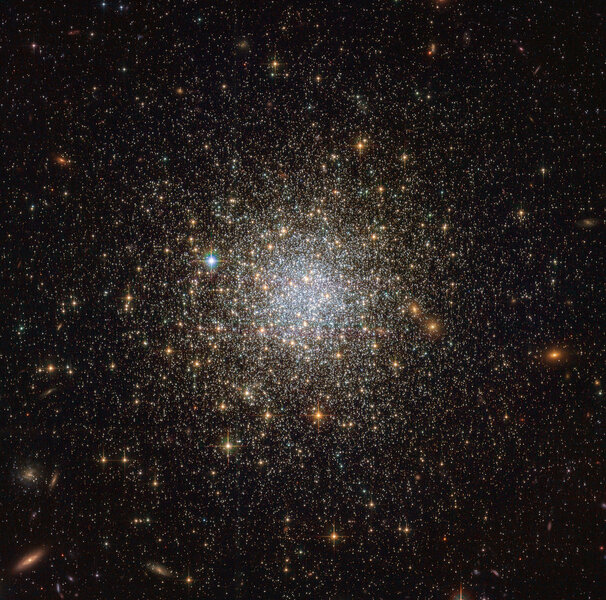Create a free profile to get unlimited access to exclusive videos, sweepstakes, and more!
Breaking down the structure and history of a nearby — and weird — galaxy
Centaurus A is under scrutiny as it eats other galaxies.

How are galaxies built?
That’s a hard question to answer. Galaxies are huge structures, with million, billions, and sometimes trillions of stars. They’re huge, tens of thousands of light years across, with the largest topping half a million light years in size. They’re one of the most basic self-gravitating structures in the Universe, the basic component of clusters, and superclusters. And they’re old, nearly as old as the cosmos itself; they were among the first structures to form after the Big Bang.
Most are so far away that we’re only now starting to have technology that can see individual stars and structures in them. Ironically, we’re inside the Milky Way, so it’s spread all over the sky, making it hard to get an idea of its structure. But there are some galaxies close enough to us that we can see them in detail, but far enough away that they’re not too spread out.
A perfect example of this is NGC 5128, aka Centaurus A, a massive elliptical galaxy about 12 million light years from us. Even a glimpse shows it to be odd; elliptical galaxies are generally not making stars, so they appear reddish as young blue stars die off, and they don’t tend to have a lot of dust — dark clouds of molecules made by stars as they die. Yet Cen A, as those in the know call it, has a huge band of dust cutting right across its middle. It’s a near certainty that Cen A recently ate a spiral galaxy rich in young stars and dust, creating that belt around its middle.
Models of how we think galaxies form in the Universe indicate they build themselves up in many ways from the bottom up: They merge with smaller galaxies, growing over time. The models appear to work, but we need details to make sure they’re getting things right. Looking at dwarf galaxies around bigger ones can feed data to those models. We also need info about these galaxies’ globular clusters, which are roughly spherical collections of tens of thousands up to over a million stars, all in small balls just a few dozen light years across.
Enter PISCeS, the Panoramic Imaging Survey of Centaurus and Sculptor. This is a wide and deep survey of the sky using the huge Magellan 6.5-meter telescope, looking around Cen A as well another galaxy called NGC 253, a spiral in the constellation of Sculptor. By studying the populations of these galaxies in detail, astronomers hope to build better models of how they formed.
The survey is ongoing, but already producing results for Cen A. They imaged 80 separate fields of the sky around it, each about the apparent size of the full Moon, totaling 11 square degrees. That’s a big hunk of sky, and in real space it reaches out about a half a million light years from the center of Cen A. They’ve seen hundreds of thousands of individual stars in the galaxy, allowing them to map things like their distribution, distances, and colors (important for understanding their age).
The survey is returning a bounty of info. They’ve discovered nine confirmed new dwarf galaxies, including one that’s actively being torn apart by Cen A’s mighty gravity, showing that the galaxy is still growing today. They also see streams of stars from ancient galaxies torn apart, and stars distributed in shell-like structures that are also likely due to disrupted dwarf galaxies that collided with Cen A long ago.
Of particular interest to me is that they found a lot of globular clusters. A lot. Globulars appear as blobs slightly bigger than stars at that distance, though in smaller telescopes they can look like stars, and it can be hard to tell real globulars from foreground stars in our own Milky Way. Here they got clever: The astronomers with PISCeS looked at data from the Gaia mission, which maps the locations, motions, colors, and distances of over a billion stars in the Milky Way, and also sees objects in other galaxies as well. They could eliminate a lot of what looked like globular candidates if they showed too much motion or were too close to us, indicating they’re actually nearby stars.
In the end they wound up with a staggering 40,502 candidate globular clusters. That’s phenomenal. Now, most of these are probably not real, but still made the cut for candidates based on various criteria. Being stingier with their parameters, they think that some 1,900 of them need more observations, specifically spectra taken to see if they match what we know about what globulars look like.
That’s still a huge number. Mind you, we only know of about 160 globular clusters in the Milky Way, and we live in it! To see more than 10 times as many in another galaxy is a huge achievement. I had to laugh; using their findings they predict that Cen A probably has 1,450 ±160 globulars; their uncertainty is as many globulars as we know of in the Milky Way. That’s a lot of clusters.
All of this will help them understand better what Cen A looks like now, how it’s affecting its environment, what it’s done in the past, and maybe even how it came to be the complex, gorgeous structure it is today. And from there we learn more about galaxies themselves, which in turn means we understand the Universe as a whole better.
Every piece of the cosmic puzzle counts, and leads to discovering more pieces, to knowing them better. That’s the whole point of science.




























